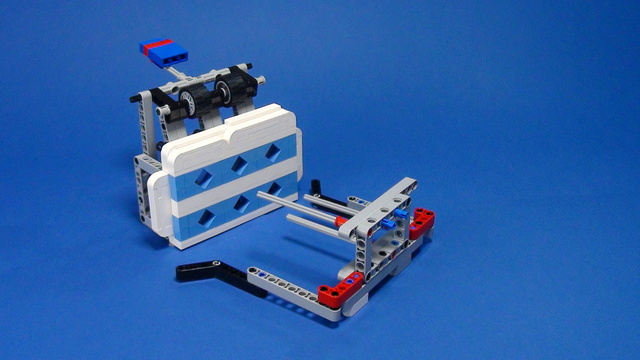In this tutorial of the series we would get into more details on how the flywheel works, what's its purpose and how the whole attachment is triggered with the first rubber band.
In this tutorial of the series we would get into more details on how the flywheel works, what's its purpose and how the whole attachment is triggered with the first rubber band.
As you so in the previous video - Rubber band attachment with a flywheel - solving FLL 2014 Search Engine (part 1), the FIRST LEGO League 2014, World Class, Search Engine mission is very interesting. We are accomplishing it by slowly and precisely pushing to the mission model.
The attachment is a pinless attachment build for the EV3 competition robot.
Kiril Mitov's most favourite attachment. To quote him "I had a really great fun building this attachment and recording the videos for it".
It's an attachment with a Rubber band and a Flywheel and a Gear Wheel and a Worm Gear. So much knowledge in just one small attachment. The goal of the attachment is to be able to have an active attachment without actually having a motor. So you can place that attachment and it will do the work for you instead of using a motor to power it.
Build with LEGO Mindstorms EV3 set.
When placing the rubber bands check out the tutorials
Placing the white rubber band is shown at https://www.fllcasts.com/tutorials/105-rubber-band-attachment-with-a-flywheel-solving-fll-2014-search-engine-part-2 at around 05:40.
Placing the red rubber band is shown at https://www.fllcasts.com/tutorials/104-rubber-band-attachment-with-a-flywheel-solving-fll-2014-search-engine-part-1
- Previously, when we were discussing the rubber band attachment that was solving 2015 World Class Mission Challenge, and it is a rubber band attachment with the rubber bands, and it has quite interesting mechanism, and there is a lot of physics involved in this attachment. As you can see currently, when I push the axle, we see the attachment driving slowly, and pushing to the mission model. Check out the previous video. Today, we're gonna discuss how exactly does the attachment works, and to why we have gear wheels, where is the rubber band, and for the purpose of this flywheel over here. Now, just as a reminder, for the attachment, it was a pinless attachment. We can place the robot over the attachment. We also have this stopper here when we push to the wall, so that the attachment does not bend. We have the worm gear over here that is holding the attachment loaded, and we must push to the axle, so that we can release it. And we also have this small part here, that are actually driving the worm gear when we are pushing to the worm gear. This is introduction to the attachment. Now, we have the flywheel. The purpose of the flywheel was to make the movement of this part here slow. Let's deconstruct part of the attachment. Let's see what's inside. The problem that we are solving is as following: because we have the laws of physics that energy is always conserved, so it's-, so we never lose energy; and we also have the mission model, and we must push to the mission model. And we must push to the mission model slowly but there's a certain power involved here, so it requires a certain force. That's why we have this flywheel over here, and the gear mechanism. So, we have one gear, two gears-, two gear wheel, three, four; we have a mechanism of five gear wheels. When inside in these frames, we have a rubber band. This rubber band is released and it rotates the gear wheels. When it rotates the gear wheels, it rotates them quite fast. So, we have the gear mechanism to reduce the speed of rotation. But as we reduce the speed of rotation, part of the energy from the rotation of the gears is conserved in the flywheel. And at the next stage when the flywheel actually has to push, part of the energy from the flywheel is returned back to the system, and we can push on the mission model. So again, we have a flywheel and a system of gears. The system of gears reduces the speed, the speed of rotation generated by the rubber band. Part of the energy is conserved in the flywheel and at the second later when we actually push to the mission model. Part of the energy is again returned from the flywheel to the gear system, and we can push actually on the mission model. Let's now remove the flywheel and see what's inside the attachment. We have a system of two gear wheels here. I'll remove this part holding the axle. And the upper side of the-, of this gear system, we have two black gear wheels, I'll also remove them. One second, let's now remove the frame. And as I remove the frame, we can see that we have a small gear wheel that is driving we have the large gear wheel that is driving the small gear wheel. And inside, we'll have the rubber band removed. Large gear wheel and I'll continue deconstructing the attachment.
I want to open this so that you can see the rubber band. As I have deconstructed the attachment, we can actually finally see the rubber band right here. And when we load the attachment, we can see how we rotate the axle. And we have the rubber band right here, it's a white rubber band. And now I don't have the whole attachment, so I can't stop but-, as I stop it now with the axle, you can see that there is some force from the rubber band to the axle. And if I now release, it will rotate. Again, this here is the rubber band. So, this is a very interesting attachment. You can find the instructions below for building this attachment and choosing it in other competitions. And in some of the next video, we will enter into more details on the physics of this attachment, and how exactly we transfer power from the rubber band to the gear wheel and to the flywheel, and from then to the power that is actually pushing on the mission model.
Този Урок е използван в следните курсове и занятия.

This course is a collection of materials for many of the attachments that we've built at FLLCasts before introducing courses. The videos were built as separate different attachments for different competitions and with the following course, we try to give it a structure.

Let's try to integrate more of the things we have learned into a single attachment. One that could accumulate energy, conserve it and use it at the appropriate time. All this because of a Rubber Band and a Flywheel - and if you don't know what a flywheel is you should definitely watch this videos

This course is a collection of materials for many of the attachments that we've built at FLLCasts before introducing courses. The videos were built as separate different attachments for different competitions and with the following course, we try to give it a structure.

In this video tutorial we experiment with different ways of solving the sports mission for throwing the ball. We show seven different LEGO MIndstorms EV3 and NXT robot constructions and attachements. Most of the techniques could be applied for any mission involving throwing a ball or an object.

These are a couple of structured examples and tutorials of how the missions for FIRST LEGO League 2014 Word class competition could be accomplished. We've gathered recordings and explanations from which students and teacher can learn a lot. There are missions and attachment for rubber bands, lifting with rubber bands, throwing and other interesting and challenging robotics missions from the competition.

Let's try to integrate more of the things we have learned into a single attachment. One that could accumulate energy, conserve it and use it at the appropriate time. All this because of a Rubber Band and a Flywheel - and if you don't know what a flywheel is you should definitely watch this videos